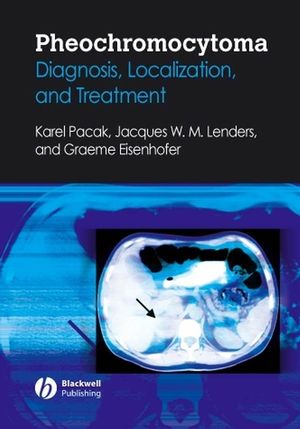Pheochromocytoma: Diagnosis, Localization, and TreatmentISBN: 978-1-4051-4950-1
Hardcover
184 pages
August 2007, Wiley-Blackwell
 |
||||||
2 Historical comments.
3 Pathology.
4 Clinical presentation of pheochromocytoma.
4.1 Signs and Symptoms.
4.2 Differential Diagnosis.
4.3 Special Presentations.
4.3.1 Diagnosis of Pheochromocytoma in Patients with an Incidentally Discovered Adrenal Mass.
4.3.2 Pheochromocytoma as an Endocrine Emergency.
4.3.2.1 Hypertensive Crisis.
4.3.2.2 Hypotension and Shock.
4.3.2.3 Multisystem Failure.
4.3.2.4 Cardiac Emergencies.
4.3.2.5 Acute Peripheral Ischemia.
4.3.2.6 Pulmonary Emergencies.
4.3.2.7 Gastrointestinal Emergencies.
4.3.2.8 Nephrological Emergencies.
4.3.2.9 Neurological Emergencies.
4.3.3 Malignant Pheochromocytoma.
4.3.4 Pheochromocytoma in Children.
4.3.5 Pheochromocytoma in Pregnancy.
4.3.6 Pseudopheochromocytoma.
4.3.7 Factitious Pheochromocytoma.
5 Current trends in genetics of pheochromocytoma.
5.1 MEN Syndromes.
5.1.1 Diagnostic Approaches.
5.2 VHL Syndrome.
5.3 NF Type 1.
5.4 Succinate Dehydrogenase Gene Related Pheochromocytoma.
5.5 Genetic Problems in Sporadic and Other Pheochromocytomas.
6 Catecholamines and adrenergic receptors.
6.1 Synthesis and Sources of Catecholamines.
6.2 Synthesis of Catecholamines in Pheochromocytoma.
6.3 Storage and Release of Catecholamines by the Sympathoadrenal System.
6.4 Uptake and Metabolism of Catecholamines Produced by the Sympathoadrenal System.
6.5 Catecholamine Metabolism in Hepatomesenteric Organs.
6.6 Catecholamines Metabolism and Release by Pheochromocytoma.
6.7 Kinetics and Elimination of Catecholamines and Their Metabolites.
6.8 Pharmacology of Catecholamine Systems: Implications for Pheochromocytoma.
6.9 Physiology of Catecholamine Systems.
6.9.1 Adrenal Medullary Hormone System.
6.9.2 Peripheral Dopamine Systems.
6.10 Adrenergic Receptors and Their Functions.
6.11 Actions of the Catecholamines.
7 Current trends in biochemical diagnosis of pheochromocytoma.
7.1 Biochemical Tests of Catecholamine Excess.
7.2 Measurement Methods.
7.3 Reference Intervals.
7.4 Initial Biochemical Testing.
7.5 Follow-up Biochemical Testing.
7.6 Collection and Storage of Plasma and Urine Specimens.
7.7 Interferences from Diet and Drugs.
7.8 Pharmacologic Tests.
7.9 Additional Interpretative Considerations.
7.10 Summary.
8 Current trends in localization of pheochromocytoma.
8.1 Anatomical Imaging of Pheochromocytoma.
8.1.1 Computed Tomography.
8.1.2 Magnetic Resonance Imaging.
8.2 Functional Imaging of Pheochromocytoma.
8.2.1 MIBG Scintigraphy.
8.2.2 Positron Emission Tomography.
8.2.3 Somatostatin Receptor Scintigraphy (Octreoscan).
8.2.4 Current Imaging Algorithm.
9 Treatment of pheochromocytoma.
9.1 Medical Therapy and Preparation for Surgery.
9.2 Postoperative Management.
10 Future trends and perspectives.
10.1 Genomics in Pheochromocytoma Research.
10.2 Proteomics in Pheochromocytoma Research.
10.3 Future Therapeutic Modalities for Pheochromocytoma.
References.
Index



